Which of the following statements about retrospectives is true?
The four test levels used in ISTQB syllabus are:
1. Component (unit) testing
2. Integration testing
3. System testing
4. Acceptance testing
An organization wants to do away with integration testing but otherwise follow V-model. Which of the following statements is correct?
Test automation allows you to:
Which ONE of the following options BEST describes Behavior-Driven Development (BDD)?
Pariksha labs is a mature software testing company. They are TMMi level 5 certified. Their testing processes are well defined. Which ONE of the following statements is likely to be CORRECT about them?
Which of the following work products cannot be examined by static analysis?
Which ONE of the following elements is TYPICALLY used to guide testing duringexploratory testing?
Which of the following statements is CORRECT?
A requirement specifies that a certain identifier (ID) must be between 5 and 10 characters long, must contain only alphanumeric characters, and its first character must be a letter. As a tester, you want to apply one-dimensional equivalence partitioning to test this ID. This means that you have to apply equivalence partitioning individually: to the length of the ID, the type of characters contained within the ID, and the type of the first character of the ID.
What is the number of partitions to cover?
You are a tester working on a critical project. Based on the risk analysis you need to decide on the order of test execution. Which of the following lists the correct sequence of test execution? Priority 1 is the highest and Priority 3 is the lowest priority.
Test CasePriorityDependencies
Test A3-
Test B1TestD
TestC2Test A
Test D3•
After being in operation for many years, a document management system must be decommissioned as it has reached its end of life. This system will not be replaced by any other new system. A legal obligation provides that all documents within the system must be kept for at least 20 years in a state archive.
Which of the following statements about maintenance testing for decommissioning of this system is true?
An alphanumeric password must be between 4 and 7 characters long and must contain at least one numeric character, one capital (uppercase) letter and one lowercase letter of the alphabet.
Which one of the following sets of test cases represents the correct outcome of a two-value boundary value analysis applied to the password length? (Note: test cases are separated by a semicolon)
Which of the following statements refers to a good testing practice that applies to all software development lifecycles?
For each test case to be executed, the following table specifies its dependencies and the required configuration of the test environment for running such test case:
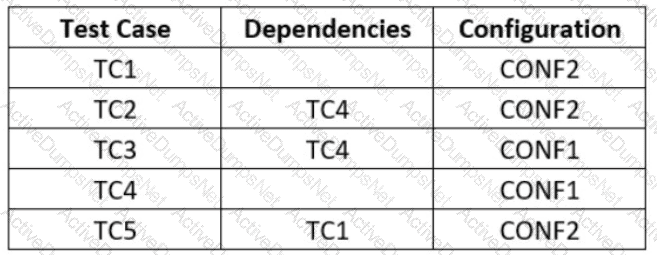
Assume that CONF1 is the initial configuration of the test environment. Based on this assumption, which of the following is a test execution schedule that is compatible with the specified dependencies and allows minimizing the number of switches between the different configurations of the test environment?
Consider the following simplified version of a state transition diagram that specifies the behavior of a video poker game:
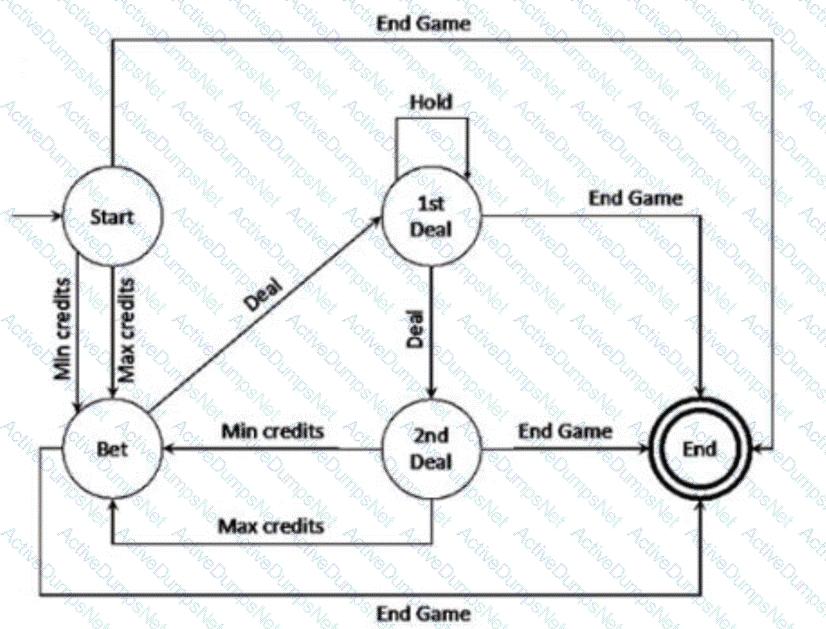
What Is the minimum number of test cases needed to cover every unique sequence of up to 3 states/2 transitions starting In the "Start" state and ending In the "End" state?
Which of the following statements best describes how configuration management supports testing?
Which of the following statements is true?
Match the Work Product with the category it belongs to:
Work Product:
1.Risk register
2.Risk information
3.Test cases
4.Test conditions
Category of work products:
A test manager has started a cycle of testing for an e-commerce application. The reason for testing is the change in the protocol for connecting to the payment gateway because of new regulations. Which of the following correctly names this type of testing?
An organization is working on updating test cases for a particular module of their software.
Sam updated a set of test cases yesterday and saved the new version on his PC.
Unfortunately, the hard disk of his PC crashed, and his work was lost.
The IT department of the organization restored the contents of his hard disk with the last available back-up - from the previous morning. However, the changes made by him yesterday were lost forever.
Which of the following tools, had it been used, would have prevented the loss of Sam's updates?
An agile software development organization has recently hired a senior tester. The organization has distributed teams spread across time zones. They need to share test status with various stakeholders including upper management and customers at a regular interval. Which of the following statements seems to be correct with regards to the communication?
Which of the following statements about the test pyramid is true?
The fact that defects are usually not evenly distributed among the various modules that make up a software application, but rather their distribution tend to reflect the Pareto principle:
A test status report should:
Which ONE of the following options contains the statements (I - V) that MOST ACCURATELY characterize acceptance test levels?
I. Acceptance test levels focus on validating and demonstrating readiness for deployment.
II. Acceptance test levels must be performed by an independent test team.
III. Acceptance test levels often require specific support, such as test harnesses.
IV. Acceptance test levels ideally should be performed by the intended users.
V. Acceptance test levels use component specifications as the test basis for the system.
A software company decides to invest in reviews of various types. The thought process they have is that each artifact needs to be reviewed using only one of the review methods depending on the criticality of the artifact.
Which of the following is not an example of a typical content of a test completion report for a test project?
Consider the following table, which contains information about test cases from the test management system:
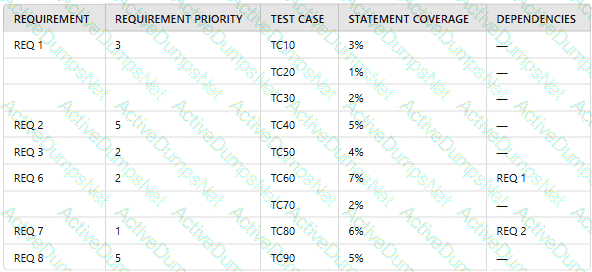
Which ONE of the following optionsorganizes the test cases based on the statement coverage strategy, while considering practical constraints?
As a tester, as part of a V-model project, you are currently executing some tests aimed at verifying if a mobile app asks the user to grant the proper access permissions during the installation process and after the installation process. The requirements specification states that in both cases the app shall ask theuser to grant access permissions only to the camera and photos stored on the device. However, you observe that the app also asks the user to grant access permission to all contacts on the device. Consider the following items:
[I]. Test environment
[II]. Expected result
[III]. Actual result
[IV]. Test level
[V]. Root cause
Based on only the given information, which of the items listed above, are you able to correctly specify in a defect report?
Which of the following IS the BEST example of whole team approach
A typical test objective is to:
Which of the following statements is CORRECT about the value added by a tester to release planning?
Which of the following types of bug are more likely to be found by static testing then by dynamic testing?
Which of the following statements about error guessing is true?
Which of the following statements about static testing and dynamic testing is true?
Shripriya is defining the guidelines for the review process implementation in her company. Which of the following statements is LEAST likely to have been recommended by her?
Consider the followinguser storyand itsacceptance criteria:
User Story:
As a member of the"Agnotoly"association, I want to be able topay the association’s dues through an automatic payment methodso that I can forget about payment deadlines.
Acceptance Criteria:
The member can only pay with‘Agnesis Master’ credit card.
The member must register theircell phone number.
The member must register thecredit cardin the payment system.
The member must select apayment method (monthly or annual).
The member mustaccept the terms and conditionsfor the selected method.
If terms and conditions are accepted, the system sends anOTP(one-time password) to the member’s phone for verification.
The payment method isregistered only after OTP verification.
Once the payment method is registered, the system will charge on the first business day of the following month.
Test Cycle Results:
Members successfully paid dues using the credit card.
Payments were processedmonthly and for over a year.
Which ONE of the following options identifies the acceptance criteria that has NOT been fully covered?
Which of the following statements about the typical activities of a formal review process is true?
Determining the schedule for each testing activity and test milestones for a test project, using activity estimates, available resources, and other constraints is a typical task performed during:
Consider a review for a high-level architectural document written by a software architect. The architect does most of the review preparation work, including distributing the document to reviewers before the review meeting. However, reviewers are not required to analyze the document in advance, and during the review meeting the software architect explains the document step by step. The only goal of this review is to establish a common understanding of the software architecture that will be used in a software development project.
Which of the following review types does this review refer to?
Which of the following applications will be the MOST suitable for testing by Use Cases
Which of the following lists factors That contribute to PROJECT risks?
What does the "absence-of-defects fallacy" refer to in software development?
For each of the test cases to be executed, the following table specifies the priority order and dependencies on other test cases

Which of the following test execution schedules is compatible with the logical dependencies and allows executing the test cases in priority order?
Consider an estimation session in which a six-member Agile team (Membl,..., Memb6) uses the planning poker technique to estimate a user story (in story points). The team members will use a set of cards with the following values: 1. 2, 3, 5, 8,13, 21. Below is the outcome of the first round of estimation for this session:
Membl = 3 Memb2 = 3 Memb3 = 3
Memb4 = 21 Memb5 = 3 Memb6 = 1
Which of the following answers best describes how the estimation session should proceed?
Which ONE of the following elements is TYPICALLYNOTpart of atest progress report?
Which of the following about typical information found within a test plan is false?
Which ONE of the following options is NOT a test objective?
Which of the following is an advantage of the whole team approach?
Which of the following statements about static testing and dynamic testing is true?
Consider the following user story about an e-commerce website's registration feature that only allows registered users to make purchases:
“As a new user, I want to register to the website, so that I can start shopping online”
The following are some of the acceptance criteria defined for the user story:
[a]The registration form consists of the following fields: username, email address, first name, last name, date of birth, password and repeat password
[b]To submit the registration request, the new user must fill in all the fields of the registration form with valid values and must agree to the terms and conditions
[c]To be valid, the email address must not be provided by free online mail services that allow to create disposable email addresses. A dedicated error message must be presented to inform the new user when an invalid address is entered
[d]To be valid, the first name and last name must contain only alphabetic characters and must be between 2 and 80 characters long. A dedicated error message must be presented to inform the new user when an invalid first name and/or the last name is entered
[e]After submitting the registration request, the new user must receive an e-mail containing the confirmation link to the e-mail address specified in the registration form
Based only on the given information, which of the following ATDD tests is most likely to be written first?
Which of the following statements describes regression testing?
I. Retesting of a fixed defect
II. Testing of an already tested program
III. Testing of new functionality in a program
IV. Regression testing applies only to functional testing
V Tests that do not nave to be repeatable, because They are only used once
Which of the following statements is true?
A program is used to control a manufacturing line (turn machines on and off. start and stop conveyer belts, add raw materials to the flow. etc.). Not all actions are possible at all times. For example, there are certain manufacturing stages that cannot be stopped - unless there is an emergency. A tester attempts to evaluate if all such cases (where a specific action is not allowed) are covered by the tests.
Which coverage metric will provide the needed information for this analysis?
Which of the following statements about branch coverage is true?
An application is subjected to a constant load for an extended period of time as part of a performance test. While running this test, the response time of the application steadily slows down, which results in a requirement not being met. This slowdown is caused by a memory leak where the application code does not properly release some of the dynamically allocated memory when it is no longer needed.
Which of the following statements is true?
Scenario 2 “Big Drop”:
The management of the company “The Big Drop” has instructed the Product Team to configure the discounts in the sales terminals so that frequent customers receive an additional discount on top of a bulk discount, based on the following table:
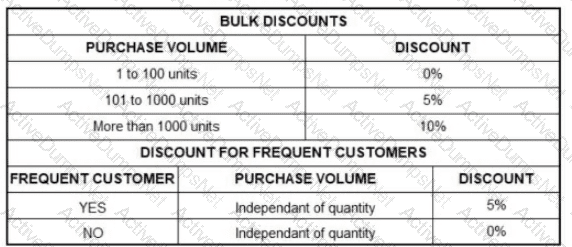
Question:
You must design test cases to represent allPOSSIBLEandREALbusiness scenarios. Test cases should be generated using the input data provided in the table above.
How many POSSIBLE decision rules can be extracted from the table above?
Which ONE of the following activities TYPICALLY belongs to the planning phase of the review process?
Scenario 1 “Happy Tomatoes” (used for questions 20-22):
An intelligent application for agricultural use incorporates temperature sensors located at different points of an enclosure. The sensors measure and record the temperature at regular intervals and extract the statistical values for these measurements. These values include the average daily temperature.
A new variety of tomatoes is currently being grown and the“World Organization for Happy Tomatoes”has established temperature ranges related to vegetative development.
When the system establishes that the average temperature is within a specific range, it emits a value that will be used to monitor and control the crop.

Using theequivalence partitioningtechnique, identify the set of input values that provides the HIGHEST coverage.
The following 4 equivalence classes are given:
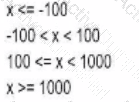
Which of the following alternatives includes correct test values for x. based on equivalence partitioning?